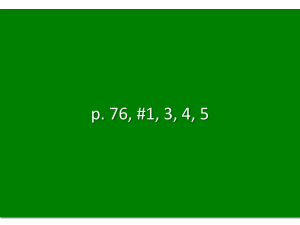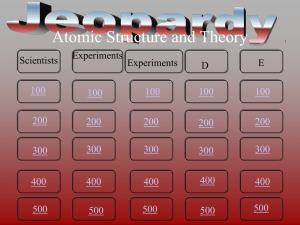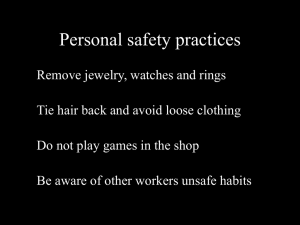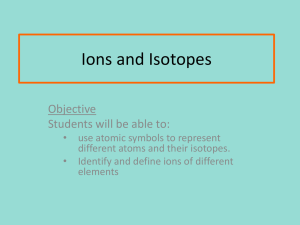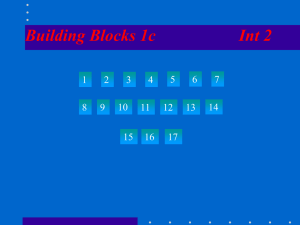Chapter 4 notes sections 1,2 and 3
advertisement
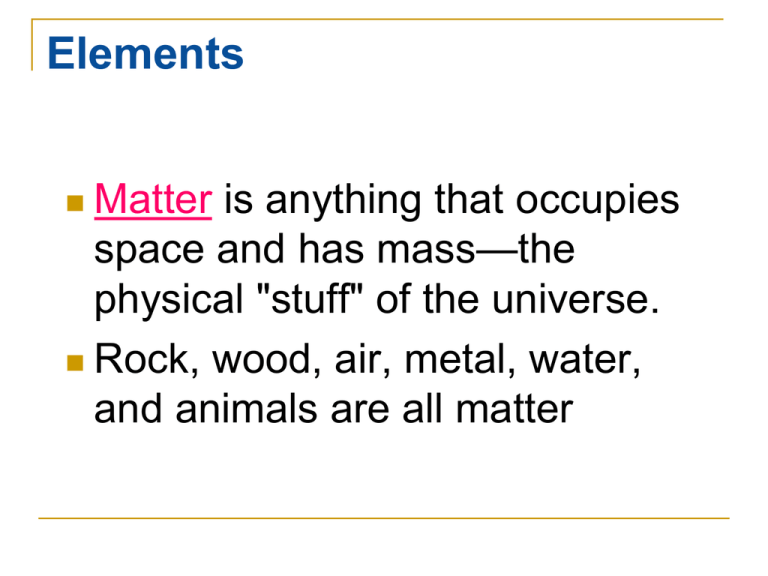
Elements Matter is anything that occupies space and has mass—the physical "stuff" of the universe. Rock, wood, air, metal, water, and animals are all matter Matter Elements The various forms of matter are composed of one or more chemical elements. An element is a pure substance that cannot be broken down into other substances by chemical means. Examples of naturally occurring elements include gold, helium, mercury, and oxygen. Elements About 25 elements are essential to life. Four of these element: oxygen (O), carbon (C), hydrogen (H), and nitrogen (N) - make up about 96 percent of the living matter in your body. Elements Calcium (Ca), phosphorus (P), potassium (K), sulfur (S), and a few other elements account for most of the remaining 4 percent. Trace elements, elements that make up less than 0.01 percent of your body mass, are nevertheless critical to your health.. Molecules and Compounds Most elements can interact with other elements, forming molecules and compounds A molecule is formed when two or more atoms join together chemically. Molecular hydrogen (H2), molecular oxygen (O2) and molecular nitrogen (N2) are not compounds because each is composed of a single element. Molecules and Compounds A compound is a molecule that contains at least two different elements. All compounds are molecules but not all molecules are compounds. Water (H2O), carbon dioxide (CO2) and methane (CH4) are compounds because each is made from more than one element. The smallest bit of each of these substances would be referred to as a molecule. For example, a single molecule of molecular hydrogen is made from two atoms of hydrogen while a single molecule of water is made from two atoms of hydrogen and one atom of oxygen. When two or more elements are bonded together we have a MOLECULE. When those elements are different and bonded together we have a COMPOUND. Atoms Each element consists of a single kind of atom that is different from the atoms of all other elements. An atom is the smallest possible particle of an element. Atoms Atoms of all elements are made up of even smaller components called subatomic particles. A proton is a subatomic particle with a single unit of positive electrical charge (+). An electron is a subatomic particle with a single unit of negative electrical charge (-). A third type of subatomic particle, the neutron, is electrically neutral. Atoms An element's physical and chemical properties depend on the number and arrangement of its subatomic particles. For example, the shiny luster of copper metal and the boxy crystals of sulfur are based on the structure and interactions of the atoms that make up those elements. Atoms An atom's protons and neutrons are tightly packed together, forming a central core called the nucleus. Electrons, which have much less mass than neutrons and protons, continually move about the outside of the nucleus at great speed. The attraction between the negatively charged electrons and the positively charged protons keeps the electrons close to the nucleus. Atoms An important difference among elements is the number of protons in their atoms. All atoms of a particular element have the same number of protons, known as the element's atomic number. A helium atom, with 2 protons, has an atomic number of 2. Left alone, an atom tends to hold as many electrons as protons. In that state, the atom is electrically neutral—the positive charges on the protons exactly balance the negative charges on the electrons. Atoms The number of electrons is not constant like the number of protons. Certain atoms can lose one or more electrons, while some atoms can gain one or two electrons. The number of electrons determines how the atom interacts with other atoms. Indirectly then—by setting the usual number of electrons—the number of protons determines the atom's properties. No two elements have the same atomic number (proton number), so no two elements have the exact same chemical behavior. Electrons and Reactivity How does an atom's structure determine how it reacts with other atoms? The key is the atom's electrons. Electrons differ in the amount of energy they have and how tightly they are held by the protons in the nucleus. Based on these properties, chemists describe an atom's electrons as belonging to certain energy levels. Usually it is the electrons in the highest energy level of an atom that determine how that atom reacts. Electrons and Reactivity The first, or lowest, energy level (nearest the nucleus) can hold 2 electrons, while the second energy level can hold 8 electrons. For example, a hydrogen atom has 1 electron. Since electrons fill the lowest energy level first, hydrogen's electron occupies its first energy level. Electrons and Reactivity Helium has 2 electrons, filling its lowest energy level. Carbon has 2 electrons in its lowest energy level, and 4 more electrons in its second level. Note that both hydrogen and carbon have a partly-filled energy level, as do nitrogen and oxygen. Note: the outermost energy level electrons are called VALENCE ELECTRONS Electrons and Reactivity That condition makes these atoms chemically reactive—they tend to react with other atoms, filling their highest occupied energy levels. In contrast, a helium atom, which has no partly-filled energy levels, is inert—it does not tend to react. Isotopes Some elements have alternate forms called isotopes. Isotopes of an element have the same number of protons in their atoms but different numbers of neutrons.. Isotopes Carbon-12 (usually written 12C), which has atoms containing 6 neutrons, makes up about 99 percent of all naturally occurring carbon. Most of the other 1 percent is carbon-13 (13C), which has atoms with 7 neutrons. A third isotope, carbon-14 (14C), has atoms with 8 neutrons and is very rare. Notice that atoms of all three carbon isotopes still have 6 protons—otherwise, they would not be carbon. Both 12C and 13C are stable isotopes, meaning their nuclei do not change with time. Isotopes The isotope 14C, on the other hand, is unstable, or radioactive. A radioactive isotope is one in which the nucleus decays (breaks down) over time, giving off radiation in the form of matter and energy. Isotopes Radioactive isotopes have many uses in research and medicine. Living cells use radioactive isotopes just as they would use the nonradioactive forms. Radioactive isotopes are useful as "biological spies" for observing what happens to different atoms within organisms. Scientists can track the presence of radioactive isotopes with instruments that detect radioactive decay.


